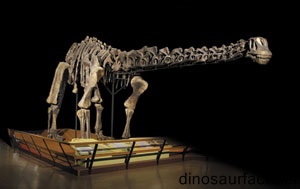 Click to visit the previous dinosaur bio
Click to visit the previous dinosaur bio
 |
|
 |
|
Kingdom: Animalia
Phylum: Chordata
Class: Sauropsida
SuperOrder: Dinosauria
SubOrder: Sauropodomorpha
Family: Haplocanthosauridae
Genus: Haplocanthosaurus
 |
|
 |
|
 |
|

Haplocanthosaurus - the Dwarf Dino of 49 Feet
The name Haplocanthosaurus stands for a dinosaur that had simple spine. It lived in this earth between 144 to 156 million years ago in the late Jurassic period. This large animal was originally named as Haplocanthus priscus by Bell Hetcher in the year 1901 when the remnants of the body were discovered in Colorado in the US. But as the name Haplocanthus priscus was occupied by some other species Bell named it Haplocanthosaurus instead of Halplocanthus. The meaning of Haplocanthus goes thus, the dinosaur with single spike.
In the year 1999 regarding Haplocanthosaurus Jose Bonaparte declared that Haplocanthosaurus differs very much from other sauropods. But they loomed large at different corners of the earth along with large animals. They had a large body and they moved in a slow pace. They needed enough food to meet the need of the metabolism. As a result they had to move frequently in quest of food all the while. The haplocanthosaurus preferred to take plants hence they had no ferocity of their own they were after their own target chewing large branches of trees all the time after their sweet will.
Haplocanthosaurus was respectively smaller in size in comparison of the other gigantic creatures. The average height was approximately 14 meters (46 feet) with 14.5 metric tons of weight. It evokes real wonder how such a small creature could cope with its giant counterparts and kept its existence secured amid the fierce ones. Haplocanthosaurus could easily be grouped with the Cetiosaurus much in resemblance with it but according to scientists it may be grouped in a separate manner for it had a structure with advanced vertebra.
The scientists classed the little Haplocanthosaurus with the Dicraeosaurus that had the same vertebra structure. But they ruled out the possibility and classed the species with another type of sauropod, the Dicraeosauridae. It was highlighted that Haplocanthosaurus had in common with the Brachiosaurus. But the features were limited to high shoulders, long neck and the short tail. It was nothing but a result of the parallel evolution that took place not through direct relationship with that one.
The body parts of the Haplocanthosaurus that were found are a partial skeleton that had no skull. The length of it was 21.5 meters and it weighed about 25 tones. The scientists are of opinion that the Haplocanthosaurus was the last one of the large Cetiosaurids. Though the Cetiosaurus are never related with the Cetiosaurus of England the body parts of the species seem to belong to other sauropods of the referred time. Naturally it comes to the mind of the scientists that the two species lived in the same period but they could not bear the burned of the mid Tithonian destruction.
According to the paleontologists, Haplocanthosaurus was regarded small in comparison with the other giants that went on scavenging the vast tracts of lush green tracts in the Jurassic period. When other Morrison sauropods had a length of about 70 feet, the Haplocanthosaurus was not more than 50 feet with an average weight of 13 metric tons. Two specimens of the dinosaurs came into the limelight so far, one is H.delfsi and the other is H.priscus.
Index
Extinct Profiles
 Triassic Dinosaurs
Triassic Dinosaurs Jurassic Dinosaurs
Jurassic Dinosaurs Cretaceous Dinosaurs
Cretaceous Dinosaurs Pterosaurs
Pterosaurs Marine Reptiles
Marine Reptiles Dinosaur Extinction
Dinosaur Extinction